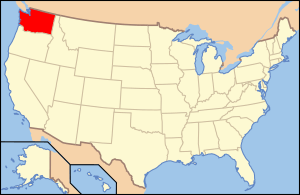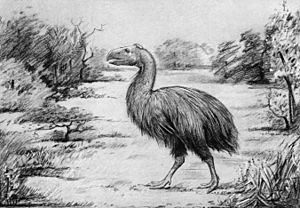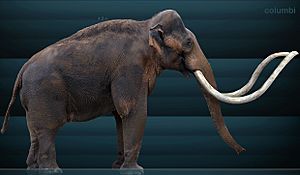Paleontology in Washington (state) facts for kids

Paleontology in Washington is all about finding and studying ancient life (fossils!) in the state of Washington. This state has a super rich collection of fossils from almost every time period in Earth's history. You can find fossils preserved in many cool ways here, like turning into rock, leaving behind molds, or even just a carbon outline.
Long, long ago, during the early Paleozoic Era, Washington was home to creatures like archaeocyathids (ancient sponges), brachiopods (shelled animals), bryozoans (tiny colonial animals), cephalopods (like squids), corals, and trilobites (ancient sea bugs).
Not many dinosaur fossils have been found in Washington from the Mesozoic Era, even though some other fossils from that time exist. This is because only about two-thirds of the state's land was formed by the end of the Mesozoic.
In the Cenozoic Era, the sea started to move away from the land towards the west. At the same time, the land environments were full of many different kinds of trees and insects. Later, bigger animals like the ancient horse Hipparion, bison, camels, caribou, and oreodonts (ancient hoofed mammals) lived here.
Even later, during the Ice Age, huge glaciers covered the northern part of Washington. But in other parts of the state, animals like bison, caribou, woolly mammoths, mastodons, and rhinoceros roamed freely. The Columbian Mammoth (Mammuthus columbi) is even the official state fossil of Washington!
Contents
Ancient Life in Washington
Life in the Paleozoic Era
During the Cambrian Period, Washington was home to archaeocyathids (ancient sponges), brachiopods, and trilobites. The archaeocyathids are the oldest known fossils found in the state!
Later, during the Ordovician Period, graptolites (tiny colonial animals) became very common. Their fossils are found in rocks in Pend Oreille and Stevens Counties today.
By the Devonian Period (and possibly the Silurian), brachiopods and corals were the most common fossils found in Washington. During the Carboniferous Period, brachiopods, bryozoans, and corals continued to live here. In the Permian Period, you could find fossils of corals, fusulinida (tiny single-celled organisms), and gastropods (snails).
Life in the Mesozoic Era
In the early Mesozoic Era, during the Triassic Period, pelecypods (like clams and oysters) were common in Washington. Fossils from the Jurassic and Cretaceous Periods are found in the north-central and northwestern parts of the state.
By the end of the Mesozoic Era, only about two-thirds of Washington's land had fully formed. During the Cretaceous Period, areas that are now the northern Cascade Mountains and the San Juan Islands were home to cephalopods (some with coiled shells, some with straight ones) and pelecypods. It's interesting to note that only one known dinosaur fossil has ever been found in Washington!
Life in the Cenozoic Era

In the Cenozoic Era, the sea in Washington began to move westward. Around the middle of the Cenozoic, volcanic activity started in the Cascade Mountains.
The seas of Washington during the Tertiary Period were filled with creatures like echinoderms (like sea urchins), foraminiferans (tiny shelled organisms), gastropods, pelecypods, and scaphopods (tusk shells).
On land, the plants included Ginkgo trees, oaks, poplars, sequoias, and willows. Ancient insects left their fossils near Spokane and west of Latah Creek.
The land animals of Washington during the Tertiary Period included the ancient horse Hipparion, bison, camels, caribou, oreodonts, and many different kinds of rodents. About ten million years ago, the Olympic Mountains were formed by the land pushing upwards.
Near the end of the Cenozoic Era, huge glaciers covered the northern third of Washington, as well as the peaks of the Cascade and Olympic Mountains. The sea creatures from the more recent Quaternary Period were usually adapted to cold climates, like pelecypods and tube-building worms. Just like the marine animals, the land animals were also adapted to cold weather. These included creatures like bison, caribou, woolly mammoths, mastodons, and rhinoceros.
Paleontology Discoveries
Important Finds and Research
On May 3, 1992, the Seattle Times newspaper announced a possible discovery: the first known footprint of a large ancient bird called Diatryma. This footprint was found in the Puget Group rock formation at Flaming Geyser State Park and dated back to the Eocene Epoch.
A few months later, on July 17, the Times reported that experts on Diatryma believed the footprint was actually a clever trick or hoax. However, in their 1999 book about fossil footprints, ichnologists (scientists who study fossil tracks) Martin Lockley and Adrian Hunt decided that the track was real after all!
In 1998, the Columbian Mammoth (Mammuthus columbi), which lived during the Pleistocene Epoch, was officially named the Washington state fossil.
People in Paleontology
Scientists Born in Washington
- Kirk Johnson was born in Seattle in 1960.
- Peter Ward was born in Seattle in 1949.
- Wesley C. Wehr was born in Everett on April 17, 1929.
Museums to Visit
If you're interested in seeing fossils and learning more about natural history in Washington, check out these museums:
- Burke Museum of Natural History and Culture, Seattle
- Charles R. Conner Museum, Washington State University, Pullman
- Slater Museum of Natural History, Tacoma
- Stonerose Interpretive Center and Fossil Site, Republic


